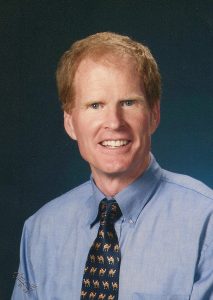Home Energy Use: How Low Can You Go?
By Jim Stelson

Jim Stelson
The cathedral ceiling, the open floor plan, the many skylights and windows, and the fetching views across Lookingglass Valley were the reasons we purchased our house in 2002. While we rejoiced in the livability of our new digs, the energy engineer in me knew I had a “real fixer upper”.
Heating and cooling is the biggest energy user in homes. The way the house is laid out, making it energy efficient presented a challenge. The cathedral ceilings allowed less than optimal insulation, the open floor plan caused warm air to stratify on the second level, and the many windows and skylights were sources of heat gain in summer and heat loss in winter. The fifteen year old heat pump struggled to keep up in summer, while paddle fans fought the stratification problem. On the plus side, this house was fairly “tight”. The original owner had caulked and weatherstripped windows and doors.
Rather than fight the stratification problem, we learned to use it to our benefit. The house has a wood stove on the lower level. Warmed air naturally rises to the loft which is quickly comfortable. If we want warmth on the lower level, I turn on the circulating fan of the heat pump and load up the stove. At night I preheat the bed with an electric blanket and sleep comfortably in a cool bedroom. On sunny summer days the lower level stays comfortable even as the loft overheats late in the afternoon. Cool nights and open windows cool the loft by morning. With this strategy of not insisting on uniform temperature throughout the house, the heat pump only runs a few hours per year.
After heating and cooling, the next biggest user of energy in a typical home is hot water. I installed a solar water heater in 2003. It performs so well I can turn my water heater off in summer. With all the “buzz” about photovoltaic solar, solar water heating is under appreciated. Mine has run reliably for thirteen years. However, solar water heating is limited in winter. Recognizing that reality, I fashioned a copper coil and snugged it to my wood stove so that I can produce hot water in winter while heating the house.
Even though I have virtually “free” heating of water, water is not free. When it came time to replace the dishwasher, I selected a model with low water use. Ditto with the washing machine. Speaking of washing machines, one of the most important energy features is how well it extracts water during the spin cycle. Better extraction means less run time for the electric dryer (which has a whopping heating element).
Refrigerators use energy 24×7. When it becomes time to replace yours, pay attention to the energy rating. Because I pick lots of berries for freezing, I did have two appliances, a freezer and a refrigerator. I found a refrigerator with a larger freezer compartment and retired the freezer. Now I have just the refrigerator, and the energy usage is less than half of what it was.
Light emitting diode (LED) lamps are now available in all sizes and configurations. They are superior in efficiency, durability, light quality, and dimmability to any other choice. I have them throughout the house. The prices and performance for LED technology continue to improve.
All electronics (TVs, sound systems, chargers, printers, etc.) draw some power even when turned off. I plug mine into a power strip and turn the power strip off when not in use. I have a laptop computer and I program it to go into “sleep” mode after 10 minutes of no keystrokes.
In December 2015, I installed a 3.4 kilowatt photovoltaic array on my roof to supply the house and charge the electric Smart Car that I use for local commutes. I sized the array to handle 100% of my electricity needs,….but oops, the electricity meter ran backwards last month and Douglas Electric credited my account for $5.48!
Energy efficiency accompanied by renewable energy production is the best path to a stable climate. I hope the ideas presented here will encourage you to discover “how low you can go” with energy and renewables in your home. Let Douglas County Smart Energy be a resource for you in your efforts.
For tips and other ways to save and produce energy, visit dcsmartenergy.org. Douglas County Smart Energy is a project of the Douglas County Global Warming Coalition. For more information about the coalition, call 541-672-9819 or find them on Facebook at Douglas County Global Warming Coalition.